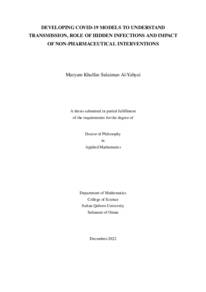Document
Developing COVID-19 models to understanding transmission, role of hidden infections and impact of non-pharmaceutical interventions.
Publisher
Sultan Qaboos University.
Gregorian
2022
Language
English
English abstract
Countries worldwide have suffered from the battle with COVID-19 and its consequences. Many
prevention and control strategies have been implemented to mitigate the spread. These measures include lockdown, quarantine, isolation, contact tracing, massive testing, and awareness
programs to encourage people to adopt social distancing and maintain personal hygiene. As
is always the case with infectious diseases, mathematical models have been used in order to
gain insights into the dynamics of COVID-19 and assess the disease intervention practices for
decision-making. Compartmental models have been constructed in this research to investigate
the dynamics of COVID-19 from different aspects. The first model investigates the environ ment's role in the disease's transmission dynamics. The second model includes three different
transmission routes, namely, asymptomatic, presymptomatic, and symptomatic transmissions,
to investigate the role of presymptomatic individuals in the disease spread. The third model
explores the role of diagnosis rate in the transmission dynamics, together with the combined
effects of quarantine and isolation. The fourth model investigates the role of different types of
quarantine and isolation in the disease transmission dynamics. The quarantine compartment is
subdivided into short and long quarantine classes, and the isolation compartment is subdivided
into tested and nontested home-isolated individuals and institutionally isolated individuals. The
fifth model assesses the impact of placing healthy individuals in quarantine and isolating in fected ones on the number of hospitalization and intensive care unit cases. The analysis of the
models includes positivity and boundedness of solutions, calculation of the basic and control
reproduction numbers and their relation to all transmission routes. Moreover, existence, and
stability analysis of disease-free and endemic equilibrium points, and bifurcation analysis are
discussed. Model parameters have been estimated using data fitting approach. Sensitivity anal ysis of the reproduction number to model parameters has also been presented for each model.
Finally, numerical simulations to demonstrate the effect of some model parameters related to the
aspect considered in each model have been carried out, and the results have been demonstrated
graphically.
Member of
Resource URL
Category
Theses and Dissertations

